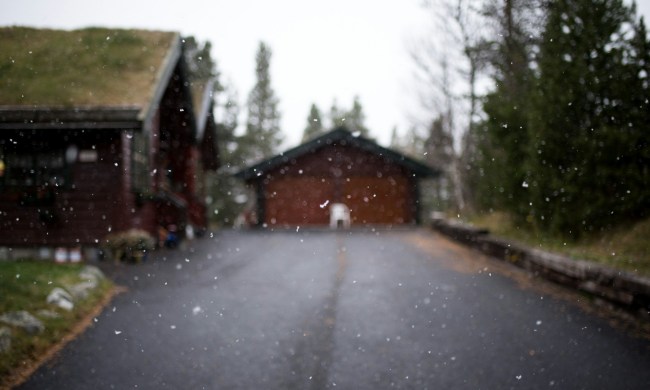Your kitchen table sees a lot of action. Aside from the everyday meals that produce nicks from glass dishes and stains from spilled food, a kitchen table is often the home’s command center. It holds your bags of groceries as you put them away, acts as your kids’ art project station, and doubles as your work-from-home desk. If your kitchen table is starting to look drab, worn, or damaged, there’s no need to buy a new one. It’s probably just time for a facelift.
By following a few simple steps and avoiding classic blunders, you can paint or stain your kitchen table in one weekend, leaving you with a beautiful, revitalized table, seemingly overnight.

Should you paint your kitchen table or stain it?
Whether you paint or stain the kitchen table depends largely on the condition and style of the table itself. Staining your table will keep that natural wood look and color, but it isn’t the best route in all situations. For example, if multiple different types of wood are present, the different woods will vary in color and appearance once stained. And, if there is significant surface damage to the wood that you can’t easily away, a stain won’t cover those blemishes as well as paint. Last, if the wood has intricate carving details, staining it will be quite difficult. In order to stain effectively, you first need to sand off the existing layers, and during this process, you may inadvertently remove some of the details that make the table so special.
In these cases, you’re better off adding a shiny new layer of paint instead of a stain.
How to paint a kitchen table
What you’ll need:
- Tarp or plastic floor lining (if painting inside)
- PPE as recommended by the manufacturer of your selected products (ie. gloves to prevent chemical burns, dust mask, etc.)
- Furniture cleaning materials
- Sandpaper in varying grit levels
- Electric belt sander
- Lint-free rags
- Paintbrushes
- Primer
- Paint
- Matte, glossy, or semi-glossy finish
Steps for painting your table:
- Lay down a tarp or plastic floor lining in your workspace to protect it from spills and drips.
- Clean your table with your preferred cleaning materials (such as dish soap, disinfectant wipes, or old mild detergents) to rid it of food, grime, and excess oils.
- Sand the surface of the table to remove the previous stain as well as any imperfections in the wood.
- Wipe the surface of the table with a lint-free cloth to remove dust particles.
- Use a paintbrush to apply a coat of primer and let it dry before adding additional coats.
- Clean the paintbrush thoroughly or grab a new one and use it to apply the paint. Let it dry thoroughly before adding at least one additional coat.
- With a clean paintbrush, apply the finish of your choice to protect it from further damage.
Best paint for kitchen table
Since your kitchen table takes a pretty good beating on a daily basis, you need to choose paint that is chip-proof and won’t wear easily. Water-based enamel paints are a great choice for the job, but be sure to pick a high-quality variety. Now is not the place to cut corners, or you’ll find yourself needing to repaint just a few months later.

How to stain a kitchen table
The process for staining your table is very similar to painting it. However, pay attention to the last few steps, as applying stain is slightly different than brushing on paint.
What you’ll need:
- Tarp or plastic floor lining (if painting inside)
- PPE as recommended by the manufacturer of your selected products (ie. gloves to prevent chemical burns, dust mask, etc.)
- Furniture cleaning materials
- Sandpaper in varying grit levels
- Electric belt sander
- Lint-free rags
- Sponge paint brushes
- Stain (preferably oil-based)
- Matte, glossy, or semi-glossy finish
Steps for staining your table:
- Lay down a tarp or plastic floor lining in your workspace to protect it from spills and drips.
- Clean your table with your preferred cleaning materials (such as dish soap, disinfectant wipes, or old mild detergents) to rid it of food, grime, and excess oils.
- Sand the surface of the table to remove the previous stain as well as any imperfections in the wood.
- Wipe the surface of the table with a lint-free cloth to remove dust particles.
- Use a sponge brush to apply a thin layer of stain to the surface of the table — the thicker the layer, the darker the stain will be. To reach your desired shade, add thin layers of stain one at a time to gradually approach the perfect hue.
- Once dry, wipe the surface with a lint-free cloth to remove excess stain and prevent it from pooling. Follow the instructions on the individual product for this step, since some stains dry differently than others.
- Repeat steps 5 and 6, applying stain and wiping away excess, until you reach your desired color.
- Use a paintbrush to apply the finish.
Your kitchen table is the focal point of the room, but it also sees the most damage. To keep this piece of homey furniture looking its best, give your table a facelift with a new coat of stain or paint to upgrade the whole room in a matter of hours.



